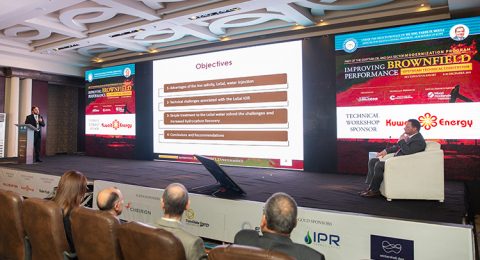By Salma Essam
Unlike micro-businesses, oil and gas projects are established upon long term cycles, taking the operators many years to fulfill. The existence of recoverable reserves acts as an obsolete uncertainty to the petroleum industry, particularly in the exploration and production phase.
In several occasions, therefore, upstream companies resort to tackle this uncertainty by divesting all or a part of their possessions in certain concession areas to another partner through farm-out agreements. Nevertheless, reconciling the competing interest of the farming-out party (farmor) with those of the farming-in (farmee) is associated with many challenges that could be contained by successful partners only.
The Level of Uncertainty
There are plenty of purposes for venturing farm-out agreements, with the need for financial assistance, technical expertise sharing, and a change in the company’s strategy being the main reasons. However, the genuine motivation behind a farm-out agreement comes from the farmor’s desire to shift the risk to another party, while the farmee seeks to leave as much of that risk as possible to the farmor, as the former generates profits.
When the farm-out agreement is being drafted, both parties have to reach a common ground, where interests on both sides are maintained. Yet, the level of uncertainty poses a huge risk, and the higher the uncertainty is, the weaker the agreement tends to be; the likelihood of disputes arises. A lack of certainty for the existence of proven hydrocarbon reserves results in unequal interests between the two parties, which would even risk finalizing the agreement. As Andrews Kurth Kenyon’s article – De-Risking Petroleum Exploration and Production – The Farm-Out Agreement, published in 2014, stated, “the balance struck between the parties to a farm-out agreement will reflect the point at which the sale and purchase of the concession interest is affected.”
The level of uncertainty in a specific concession area will reflect the fiscal terms the farmee is willing to provide as a condition to farm-in and set ground for the farmor’s expectations. This means that if a concession is poorly assessed it will certainly result in a lower level of consideration to be paid by the farmee, as a condition for taking part in the concession. Similarly, farmor’s expectations are associated with the potential degree of the asset. Revealing possible high proven reserves may turn the compass to the farmor’s benefits, consequently, increasing his headline level of considering high interest to be achieved from the concession. Thus, in both cases, the negotiating strength of the parties is of extreme importance in formulating a coherent agreement that guarantees mutual interests.
Carried Costs
The financial incentives play a key role in the farm-out agreement. According to Andrews Kurth Kenyon, the financial value obtained from the farmee could take different forms including “the recovery of costs already expended on a project, the deflection of costs that will need to be incurred on a project in the future, and the generation of a pure profit element from a concession or project.”
The terms of the farm-out agreement articulate the means, through which a farmor would take this value. Yet, the most serious challenge that occurs is the repayment of this structured value. Indeed, the carried costs paid by the farmee to the farmor – and whether or not these costs are to be repaid to the farmee – form a matter of consideration in the negotiations between the farming-out and the farming-in parties. Even though disagreements may take place while deciding upon this issue, mitigating this risk could be achieved by adhering to the specificities in defining the costs incurred.
Next to agreeing on and drafting the extent of the carry, which the farmee is offering, including potential caps on intended carried costs and settling on unspent costs; it is important to include well-formulated terms in the agreement to determine the attribution of the unspent cost i.e. whether the unspent carried costs should stay entitled to the farmor or remain with the farmee.
Deferred Payments
Another challenging issue, that correlates with the farm-out agreements, is when the farmee happens to defer part of the consideration to be paid to the farmor upon completion of the transaction. This is a method that farmees adopt to guarantee the elimination of a defined risk, to which they may be subjected to. When premiums are not paid in recognition of the payment, deferral can bring about serious concerns to the farmor. The problem is that sometimes even risks occur when there is a justifiable non-payment reason. Even though the deferred payment tends to be unappealing to the farm-out party, there are some measures that could be taken to mitigate this risk.
It is thus important that contingency events, that allow deferred payment, would be carefully defined; one of them being the reserves enhancement. This is an event where the deferred consideration is warranted under the condition that an independent third party ensures the existence of specific quantities of petroleum in a concession area. This happens through “a recognition of the migration of contingent resources to reserves through the gradation of reserves probabilities (3P to 2P; 2P to 1P), in each case by reference to an agreed method of petroleum classification,” as explained in the Andrews Kurth Kenyon’s article.
A second contingency event, namely Development Milestone, requires a deferred payment when a major development of the project agreed upon between the partners is accomplished in a determined timeframe. This milestone can include many examples such as a major commercial discovery or a governmental approval for a field development plan.
A third event is Production Milestone. The number one objective of operators is to achieve optimum quantities of production. In addition, the production milestone is a multi-level event and can take place throughout the lifecycle of the project. One of the essential measures is to ensure that this event satisfies the conditions. This can take place by appointing an auditor, working along the parameters of the industry metrics, and putting forward a mechanism that would be enforced in the event of disputes between the parties of the agreement.
In fact, the farm-out party should know it may be running credit risks if it does not receive the full value of the deferred consideration from the farming-in party. Therefore, and in order to avoid this risk, the farming-out party may require a provision that would oblige the farmee to make the payments when due. That said, transaction will be guaranteed and restored to the farm-out party on a more transparent basis.
Interest Development Conflict in JOAs
Following the completion of the farm-out agreement, the role the farmor and the farmee will play has a lot to do with the deferred considerations that holds within another challenge. If the farmor offered the entire concession for sale, then the farmor may encounter a hardship with the farmee, who would want to exercise full power in dictating the manner, in which the interest is developed for the farmor. In other words, the farmee could do little with the interest and thereby contingency events may not satisfy its criteria, thus risking the payment of the deferred consideration.
Although the farm-out agreement may include a clause that gives the right to the farmor for managing the concession interest, this will necessitate both a careful definition and consent between the farmor and the farmee. That said, the Joint Operating Agreement (JOA) plays a key role in maintaining the interests of the parties, acting as a balance for the farm-out agreement. In these cases, “the JOA comes to govern the relationship between the two parties,” explained Country Manager of Rockhopper Exploration Egypt, Samir Abdelmoaty in an exclusive interview with Egypt Oil&Gas. In essence, the JOA is a complementary phase for farming out a concession area, which, if not drafted properly, it may lead to serious issues. In the Joint Operating Agreement, alignment of interests among the partners is a cornerstone for the success of the farm-out process.
The JOA comes to regulate the voting rights for the partners that highly depend on the share in the concession. In addition, the budgeting is determined in the JOA phase and any modifications the partners wish to apply in the approved budget should refer to the JOA terms and clauses. Determining the timeline, duration, and liabilities of the farm-out takes place in the drafting process of the JOA. The operation approval is, as well, defined according the clauses agreed upon in the agreement. For example, if the farmee wants to take more interest in the concession by drilling more wells, both partners need to revise the articles in the JOA. More clearly, a joint operating agreement will determine whether or not the partners have the rights to drill more wells in a single concession.
The essence of the JOA as an indispensable component of finalizing the farm-out agreement is that it ensures whether or not the farm-out process would be successful. And in order to ensure this, the terms of this agreement should be clear and precise. In the same sense, Country Manager Abdelmoaty explained that usually “disputes happen after the drafting process of the farm-out agreements is concluded, especially, while interpreting the terms of the JOA.” If any obscurity occurs, incompliance with the wording of the agreement by one or both of the two parties may eventually “lead to arbitration.”
As the farm-out agreement has been popular in the oil and gas industry, mitigating implicated risks can save the partners huge costs. This is why the farmor should first identify its strategy, objectives, and the percentage of the concession the company wants to offer. It should also determine the number of partners it is willing to bring in. “Sometimes we need to reduce competition among the partners, so we bring more companies on board,” Abdelmoaty clarified.
Furthermore, the timing of farm-out announcement should fit with the market dynamics. For instance, there comes a time when it is not beneficial to offer concession areas for farm-outs. “If there is a bid, one should not make a farm-out call, because everybody is busy with the bid round,” Abdelmoaty noted.
In this regards, it becomes essential to observe the political and economic situation of the country and ensure a safe environment for farmees, who are more concerned about the secure business atmosphere of the operations. With that, associated risks of the farm-out agreements can be contained.








